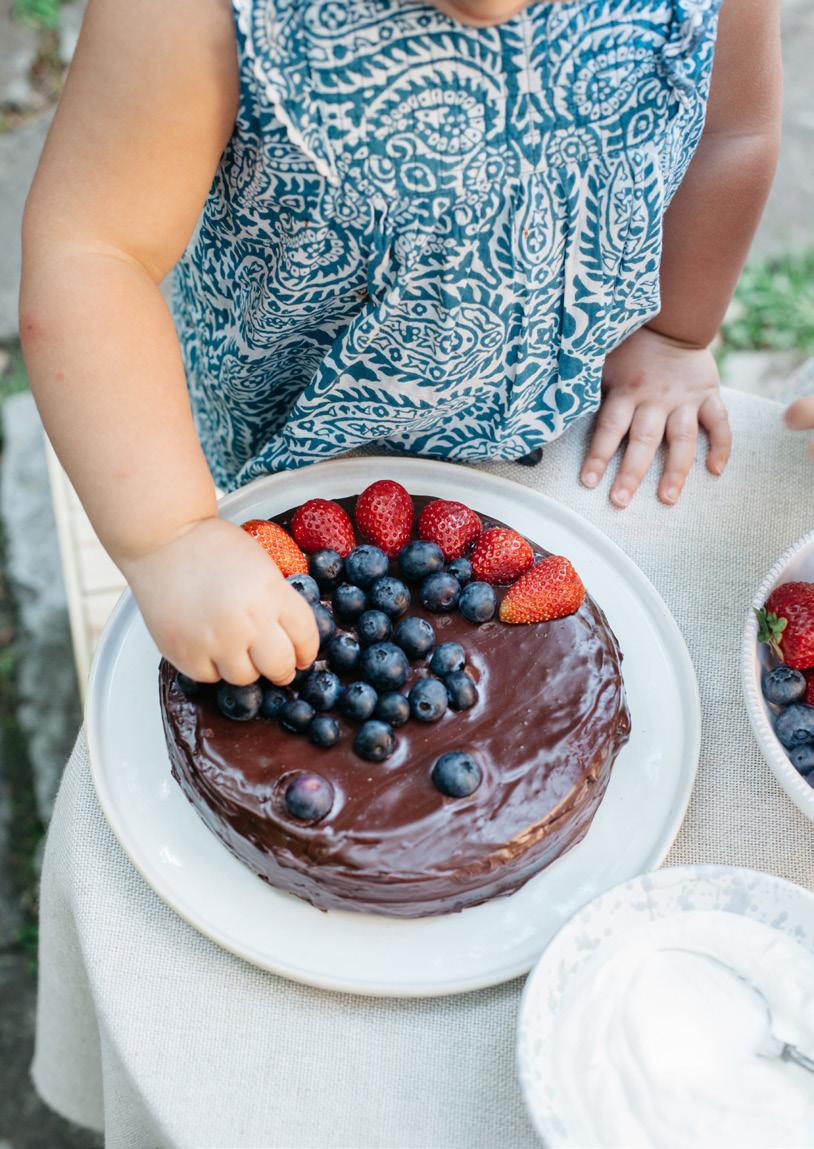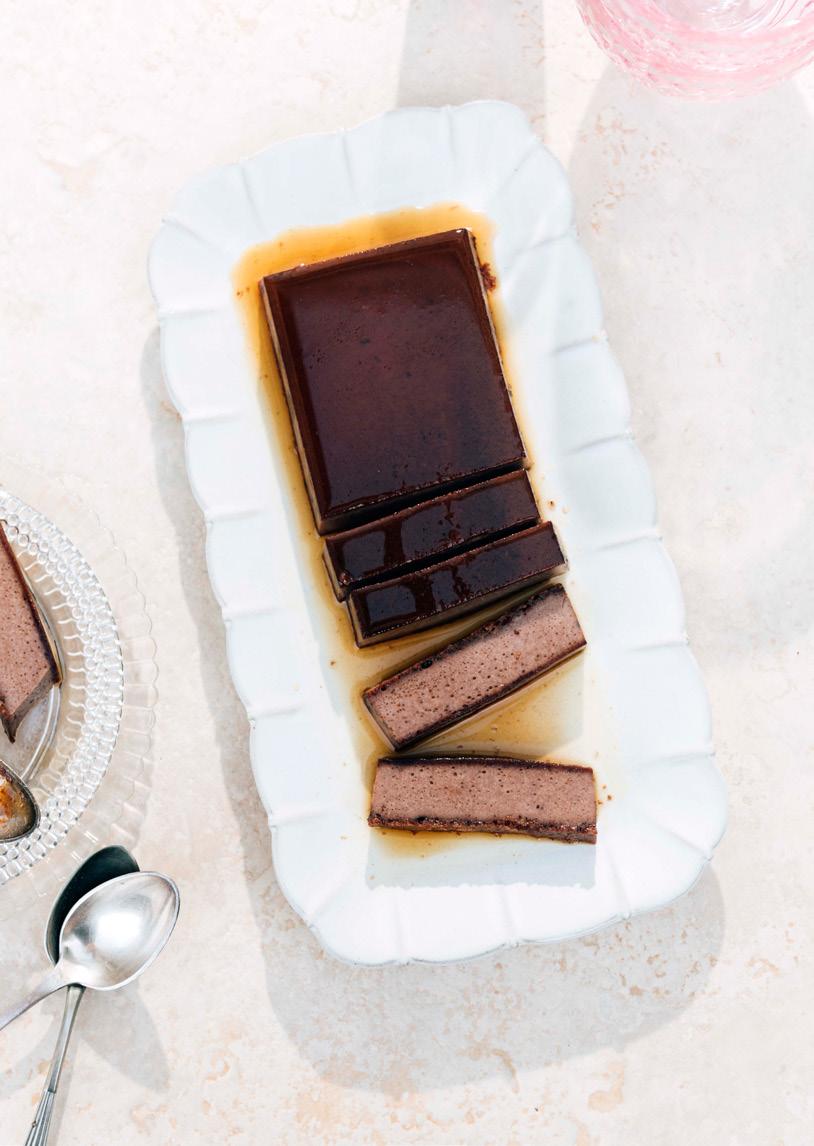
8 minute read
SWEET TREATS
by Dales Life
Sweet Freats
Italian desserts are something special. These impressive recipes taste as delicious as they look.
Advertisement
TORTA DI PERA E CIOCCOLATO This is a rich, elegant dessert

PAGNOTTELLA Halfway between a fruit cake and something dense and chocolatey

TORTA AL CIOCCOLATO An intensely deep, dark chocolate cake with a dense crumb

BONET This centuries-old dessert from Piedmont is a bit like crème caramel
PEAR AND CHOCOLATE CAKE Torta di pera e cioccolato
This is a rich, elegant dessert inspired by one from a favourite Florentine pastry shop. Sometimes you can find this cake encased in a shortcrust pastry too, but I love this on its own.
8SERVES
50g granulated sugar 2 pears, peeled, cored and cut into eighths lengthways 150g dark chocolate 90g unsalted butter, cubed 90g caster sugar 90g ground almonds 3 eggs, separated 1 teaspoon unsweetened cocoa powder, for dusting icing sugar, for dusting (optional)
METHOD
Combine the granulated sugar with 500ml water in a saucepan and set over a medium heat. Add the pear and poach for 10–15 minutes, or until tender but not too soft (a knife should easily penetrate the flesh without any resistance). Drain and let the pear pieces cool.
Melt the chocolate over a bain-marie (double boiler). When melted, remove from the heat, add the butter and stir until the butter has melted. Add the caster sugar and ground almonds, stirring to combine. When the mixture is cool, add the egg yolks.
Preheat the oven to 180°C/fan 160°C/gas 4. Grease a 22–24cm round springform cake tin and dust with the cocoa powder.
In a separate bowl, whisk the egg whites to firm peaks, then fold them into the chocolate batter. Pour the chocolate mixture into the tin. Arrange the pear pieces on the top of the batter, pushing them slightly in. Bake for 40 minutes, or until a skewer inserted into the middle of the cake comes out clean.
When cool, remove the cake from the tin and, just before serving, dust liberally with icing sugar, if desired. Serve in modest slices – this is rather rich.
Recipes are taken from 'Torta della Nonna' by Emiko Davies, with photography by Lauren Bamford and Emiko Davies, published by Hardie Grant, £16.99.
FIG AND CHOCOLATE BREAD Pagnottella
This wonderful specialty of Porto Santo Stefano on Monte Argentario in Tuscany’s south coast is halfway between a fruit cake and something dense and chocolatey, like brownies. It’s the kind of thing that you can’t find in shops or restaurants or even in cookbooks – it’s made at home by those who know the tradition best: nonnas.
12 SERVES
250g dried figs, roughly chopped 500ml white wine 1⁄4 apple, peeled, cored and grated 100g dark chocolate (70% cocoa), chopped roughly zest of 1 orange 50g sultanas 50g pine nuts 50g walnut kernels 50g whole almonds 50g whole hazelnuts, peeled 2 tablespoons unsweetened cocoa powder 2 tablespoons plum jam 1⁄4 teaspoon ground cinnamon 1⁄4 teaspoon ground nutmeg 100g plain flour or as needed, plus extra for dusting (see below) NOTE I find 100g of flour is enough, but all flours are different, and all figs will likely be different too, so use this as a guideline. You might find that your dough can take a lot more.
METHOD
Soak the figs in the wine overnight. Put the soaked figs with all the liquid in a small saucepan and add the grated apple. Bring to a simmer and cook over a low–medium heat until the fruit is soft and the liquid has reduced slightly, about 15 minutes. Blend in a food processor or with a hand-held blender until paste-like. Let it cool. Transfer the fig mixture to a large bowl and add the rest of the ingredients except for the flour and combine. Add the flour in a few stages until you have a soft and sticky mixture that has the consistency of bread dough – you may need to add a bit more or a bit less.
Preheat the oven to 160°C/fan 140°C/gas 3, line a baking tray with baking paper and dust the top with flour. Directly on the baking tray, use floured hands to shape the dough into a round loaf about 20cm wide and flatten it until it’s about 5cm tall in the centre. Dust liberally with flour on the top and blow off the excess. Bake in the oven for 25–30 minutes, or until the flour on the tray turns a cappuccinocoloured brown and the bread feels firm.
This delicious bread lasts ages and ages and ages. It’s best to keep it covered/wrapped in plastic wrap or in an airtight container, and stored somewhere cool and dry.
VARIATIONS
If you don’t have plum jam, you can use another dark jam such as grape or fig, or even substitute with honey. I like this even mixture of different nuts, but you could cut it down to one or two kinds. Just choose 200g of any nuts.
CHOCOLATE CAKE Torta al cioccolato
This is an intensely deep, dark chocolate cake with a dense crumb, reminiscent of mud cake. I like to dress it up with a topping of chocolate ganache, whipped cream and fresh berries, or dust with icing sugar.
6-8 SERVES
100g Dutch (unsweetened) cocoa powder, sifted, plus extra for dusting 200g plain flour, sifted 200g sugar 2 teaspoons baking powder pinch of salt 1 teaspoon natural vanilla extract, or 1 vanilla bean, split lengthways and seeds scraped 350ml full-cream milk (or alternative, see notes), or as needed NOTE A word on the cocoa powder. I use Dutch (unsweetened) cocoa powder, which is the most readily available type in Italy. In this process, the cocoa has been neutralised from its naturally acidic state, which makes it darker in colour, slightly more mellow in flavour, but also more soluble (for drinks such as hot chocolate). Importantly for baking, Dutch cocoa powder must be paired with baking powder rather than bicarbonate of soda. Natural cocoa powder is acidic and reacts with the baking soda to help the cake rise. You can also use natural cocoa powder here if it is all you have, but do not use bicarbonate of soda in place of the baking powder if you are using Dutch cocoa powder. It’s all about the chemistry.
METHOD
Preheat the oven to 180°C/fan 160°C/gas 4. Grease a 20cm round cake tin and dust with sifted cocoa powder. Tap upside down to remove any excess.
Place the dry ingredients together in a bowl (do make sure the cocoa powder is sifted well to ensure you don’t have problems with lumps later). Add the vanilla to the milk, then add this, bit by bit, to the dry ingredients, stirring with a wooden spoon until combined and smooth. If the batter is too stiff, you can add more milk (or even water). Pour into the tin and gently smooth the top. Bake for roughly 30 minutes, or until the centre of the cake feels springy to the touch and it smells cooked (see note) – it will be distinctly chocolatey.
When it has cooled enough to handle, remove from the tin and serve as desired – dusted with icing sugar or, when completely cooled, covered in ganache, perhaps with some berries on top or whipped cream on the side.
NOTES
I’ve experimented with countless versions of this cake, especially making it dairy-free by replacing the milk with alternatives – almond milk and coconut milk (my personal favourite, as it makes a cake so buttery you would never guess it had none); coffee, which brings out the flavour of the chocolate beautifully; and simply water (yes, it works!). I encourage you to experiment. It is quite surprising how well it works. If you find the batter is slightly stiffer than you would expect you may need to add a little more liquid.
If you are using a larger cake tin, it will be slightly thinner and you may want to check the cake a little earlier to ensure you do not over-bake this cake.
CHOCOLATE AND AMARETTI FLAN Bonet
This centuries-old dessert from Piedmont is a bit like crème caramel, but flavoured with chocolate and amaretti biscuits. It needs nothing more than the bittersweet caramel spooned over the top, but you could decorate it with whipped cream, some whole or crushed amaretti, or a sprinkling of finely chopped hazelnuts.
6-8 SERVES
butter, for greasing 175g caster sugar 4 eggs 375ml full-cream milk, warmed 15g unsweetened cocoa powder, sifted 35g amaretti (about 10 small amaretti biscuits), crushed, plus extra for decoration splash of rum, grappa or similar (optional)
METHOD
Lightly grease a loaf tin, approximately 11 × 25cm, and preheat the oven to 150°C/fan 130°C/gas 2.
Place 100g of the sugar in a saucepan and shake or tap the pan so that the sugar sits in a flat layer. Add 1 tablespoon of water and melt gently over a low–medium heat. Slowly, the sugar will melt and bubble, appearing first to look crystallised. Resist any temptation to stir it, but keep an eye on it until the sugar begins to turn liquid and then a pale amber colour. Now it will begin to change quite quickly; you can give the pan a swirl to make sure all the sugar crystals melt.
As soon as it is completely liquid and the sugar is a deep amber colour, remove from the heat and pour it into the tin. In total, this should take 5–7 minutes. Set the pan aside and let it cool.
In a mixing bowl, gently whisk the eggs and the rest of the sugar by hand. Slowly add the warm milk, along with the sifted cocoa powder. Strain the mixture into another bowl, then add the crushed amaretti and the rum, if using. Pour into the tin, over the top of the caramel, then place the tin in a large, deep baking dish. Pour hot water into the baking dish to come halfway up the side of the tin holding the bonet mixture and bake for 50 minutes, or until the top is set and springy.
Remove from the oven and leave to cool completely before chilling in the fridge for a few hours or overnight. To serve, run a thin, sharp knife around the edges of the bonet, then turn it out onto a long, flat plate. Serve in slices with the caramel spooned over the top.










